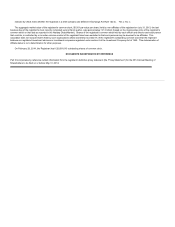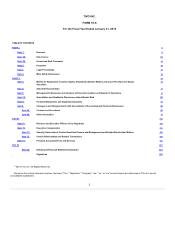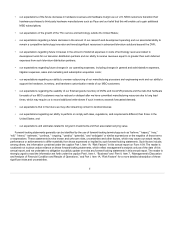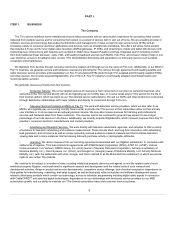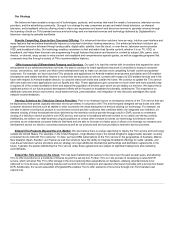TiVo 2013 Annual Report Download - page 12
Download and view the complete annual report
Please find page 12 of the 2013 TiVo annual report below. You can navigate through the pages in the report by either clicking on the pages listed below, or by using the keyword search tool below to find specific information within the annual report.
The components that make up our products are purchased from various vendors, including key suppliers such as Broadcom, which
supplies system controllers. Some of our components, including system controllers, chassis, remote controls, and certain discrete
components are currently supplied by sole source suppliers. Our dependence on these sole source suppliers could expose us to the risk of
supply shortages, unexpected price increases, and increased compliance risks with new conflict mineral requirements in the future.
We often require substantial lead time to purchase components and manufacture anticipated quantities of devices that enable the TiVo
service. This long lead time requires us to make component purchasing and inventory decisions well in advance of our peak selling periods.
We offer our individual end-users who purchase from TiVo.com a 30-day money back guarantee. We typically do not offer a right of return or
significant extended payment terms to our retailers.
Sales of our TiVo-Owned devices and subscriptions to the TiVo service are affected by seasonality. Thus, we generate a significant
number of our annual device sales and new TiVo-Owned subscriptions during and immediately after the holiday shopping season with
associated increases in revenue. We also incur significant increases in expenses in the second half of the year related to hardware costs,
revenue share and other payments to channel, and sales and marketing, subscription acquisition costs in anticipation of the holiday
shopping season. There is less seasonality associated with our MSO customers.
We believe that the principal competitive factors in the advanced television market, which includes DVRs and other broadband enabled
consumer electronic devices, are brand recognition and awareness, functionality, ease of use, content availability, and pricing. We currently
see two primary categories of competitors for the TiVo-Owned channel: DVRs offered by satellite, cable, and telecommunications operators
and advanced television products offered by consumer electronics and software companies.
Competition in the TiVo-Owned Subscription Business . Our retail products compete in the United States against services sold
directly by cable, telecommunications, and satellite operators. These products typically combine pay television reception with DVR
functionality; most of these products include multiple tuners, high definition recording, and in some cases multi-room viewing capability.
Some of these products are offered at lower prices but in many cases are bundled with other services provided by the operator and the price
for the DVR and DVR service may not be apparent to the consumer. In addition, these products are usually professionally installed and may
appeal to consumers who do not pro-actively select a DVR service. Additionally, many U.S. cable operators are currently deploying VOD
technology, which over time could serve as a substitute to our retail products. We are aware of at least one U.S. cable operator, Cablevision,
Inc., which is deploying remote storage-based DVR products. To the extent that cable operators offer regular television programming as part of
their server-based VOD offerings and DVR technology, consumers may prefer not to acquire an independent set-top based DVR through
retail channels.
Our retail products also compete against products with on-demand Internet-enabled services offered by consumer electronics companies
including:
•Personal computers: Microsoft based PCs and Apple products (among others) enable a variety of entertainment features
and services which offer alternatives to traditional DVR services, primarily via Internet delivery of content.
•Broadband capable devices and game consoles: We are seeing a proliferation of broadband enabled devices, such as
connected televisions, “smartphones”, single purpose broadband set-top boxes, tablets, and gaming consoles that offer broadband
delivered content. Though these devices do not offer the breadth of the TiVo service, they do offer alternative ways to access Internet-
delivered video content through devices that many consumers may seek to acquire for other purposes. For example, many
consumer electronics companies have television or DVD products that are Internet enabled and others have built dedicated devices
for accessing video over the Internet such as AppleTV, Roku, and GoogleTV. Similarly, companies such as Sony and Microsoft have
now enabled the digital delivery of video programming over the internet to their game consoles.
Competition in our MSO business. Our MSO revenues depend upon both our ability to successfully negotiate agreements with our
service provider customers and, in turn, upon our customers’ successful commercialization of their underlying products. We face competition
from companies such as NDS/Cisco, Ericsson (Mediaroom), Motorola/Arris, and from MSO internally developed solutions such as Comcast
X1, which have created competing products that provide user interface software for use on television set-top boxes and consumer electronic
devices.
11



